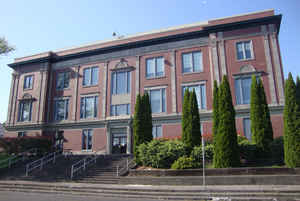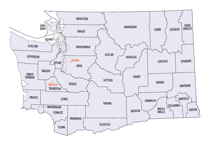Washington Counties
There are thity-nine counties in the state of Washington. Washington was carved out of the western part of Washington Territory and admitted to the Union as the 42nd state in 1889. The first counties were created from unorganized territory in 1845.Cowlitz County, Washington
Cowlitz County Education, Geography, and History

Cowlitz County is a county located in the state of Washington. Based on the 2010 census, its population was 102,410. The county seat is
Kelso, and its largest city is Longview. The county was formed on April 21, 1854 from Lewis County. Its name derives from the anglicized
version of the Cowlitz Indian term, Cow-e-liske, meaning either 'river of shifting sands' or 'capturing the medicine spirit.'
Cowlitz comprises the Longview, WA Metropolitan Statistical Area, which is also included in the Portland-Vancouver-Salem, OR-WA Combined
Statistical Area
Etymology - Origin of Cowlitz County Name
A Cowlitz word meaning seeker (in the spiritual sense).
Demographics:
County QuickFacts: CensusBureau Quick Facts
Cowlitz County History
Prior to the Europeans' arrival to the area, it was inhabited by numerous Native American tribes, with the Cowlitz tribe being the largest.
They were drawn to the region by the abundance of salmon. The Cowlitz are considered to be the first regional inhabitants to engage in
commerce as they traded extensively with other tribes in Western and Eastern Washington. The Cowlitz Indian population declined significantly
from the 1829-1830 smallpox outbreak.
European explorers discovered and began navigating the Columbia River in 1792 as British Lieutenant W. R. Broughton sailed up the river to and
past present day Cowlitz County. Then on November 5, 1805, Lewis and Clark camped at that mouth of the Kalama River, under orders from
President Thomas Jefferson. Over the following days, they would reach the present sites of Kelso and Longview.
By the 1820s, the Hudson's Bay Company had established a lucrative fur trade in the region. Furs were shipped down the Cowlitz River to the
Columbia where they were loaded and shipped around the world. Trade declined significantly in the late 1830s as over-hunting and fashions had
changed.
During the next several decades, white settlement of the region was in full swing. Most of the settlers homesteaded around the number of
tributaries that fed the Columbia River. It was during this era that the first settlements were established. The first was Monticello, near
present-day Longview. In 1841 several families with the HBC directed Sinclair expedition from Red River Colony settled there.
This was the location of the Monticello Convention where a group of prominent settlers from the Cowlitz and Puget Sound regions met to draft a
petition to the District of Columbia calling for a separate territory, to be carved out the Oregon Territory, north of the Columbia River.
This convention took place on November 25, 1852 and three months later the United States Congress formed Columbia Territory, which was later
known as Washington Territory. Being one of the first counties organized, it was created on April 24, 1854, by the newly formed Washington
Territorial Government and signed into law by Governor Isaac Stevens.
Cowlitz County
Cowlitz County was one of the first seven counties established when the Washington Territory was formed in 1853. Currently, its southern borders are defined by the Columbia and Lewis Rivers. Four other rivers, Kalama, Coweeman, Toutle, and Cowlitz and
several deeply gorged creeks contribute to the rugged landscape that challenged early settlers. Timber and transportation were major factors in the county's development. The combination of waterways, railroads and highways west of the Cascade Mountains from the Columbia River to Puget Sound has
become known as the Cowlitz Corridor.
Oliff Olson built stores first in Monticello Washington, then Freeport and Catlin, Washington. Here Charles Olson poses on one side of the store. Today the towns of Monticello, Freeport and Catlin no longer exist. The land where Monticello and Freeport were situated is now in the SE section of
Longview. The city of Catlin was incorporated into the city of Kelso in 1907.
Monticello, one of the first towns in the area, was located near the mouth of the Cowlitz River. Two years after founding the town, Darby Huntington hosted the Monticello Convention in his home. On November 25, 1852, 44 delegates signed the petition requesting Congress to create a separate territory
north of the Columbia River. Monticello became the County Seat when Washington Territory was established in 1853. The town grew as a transportation stop between Vancouver and the Puget Sound area when the most efficient means of travel was by boat, but it was frequently flooded. In 1867 a
devastating flood destroyed most of Monticello, and by the 1880's almost nothing marked the town site.
About a mile or so up the Cowlitz River from Monticello, Nathaniel Stone established the town of Freeport on his Donation Land Claim. In June 1866, Freetown was the second County Seat of Cowlitz County. Although the town was located along the river and subject to flooding, it remained prominent for
a number of years. Today Freetown is part of the City of Longview. In 1887 Freeport, Washington was spread along one road facing the river. Today the town of Freeport no longer exists; the land is now in the SE section of Longview.
As railroads began penetrating into Washington Territory, there was a need for additional towns along the railway. Kalama was built by Northern Pacific Railroad in 1870 during construction of the rail line north to the Puget Sound. For the first years (1874 to 1884), passengers and freight would
transfer to Columbia River steamers to continue their journey to Portland. It became the third County Seat of Cowlitz County in 1873.
With no bridge connecting the Oregon and Washington banks along the Columbia, a ferry was needed to ship supplies across the river. The Northern Pacific Railway Company, which built a railroad on the Oregon side of the Columbia River to Goble, Oregon, bought the second largest ferry in the world. To
ship this ferry to Oregon, crews disassembled the ferry into 57,159 pieces. They shipped it around Cape Horn, and reassembled the ferry in Portland, Oregon. The ferry, The Tacoma, transported trains - engines, cars, and all- across the Columbia between Kalama and Goble from 1884 until 1908 when the
railroad bridge was built to connect Portland and Vancouver. The ferry, Tacoma, carried the trains across the Columbia River from Kalama, Washington to Goble, Oregon from 1884 to 1908.
With the increase of settlers to the area, more towns developed. Kelso was platted by Peter Crawford in 1884 on land he had claimed in 1847, the first legal claim registered on the Cowlitz River. Named for his hometown in Scotland, Kelso was originally located on the east bank of the Cowlitz River
along the railroad and continued to grow during Territorial days. Today, as the only scheduled railroad stop in Cowlitz County and the current county seat, Kelso is a thriving community.
Castle Rock was charted in 1890, but its history as a landmark to riverboat captains was known to founder William Huntington. In the 1850s Huntington established a post office near the large rock at the south end of town. In October 2002 Castle Rock celebrated its 150th anniversary with a ribbon
cutting ceremony and a walk to the top of the Rock on a newly refurbished path. In the 1880s as Kelso, Washington grew, the local population provided their own entertainment. Here the Kelso Cornet Band poses with uniforms and instruments. Later, the picture was used by the Conn Music Company in its
advertisements.
Woodland grew into a town from Woodland Farm that had been settled by Squire and Millie Bozarth on the southern boarder of Cowlitz County. Their sons established the first school and the first post office in the area. The Hulda Klager Lilac Gardens in the center of Woodland are built around the 1889
home built by Hulda Klager's parents, Mr. & Mrs. Theil. Mrs. Klager was an internationally known lilac expert and developed many strains of lilacs. Today the gardens are open for viewing year round and in the spring (about the middle of April until Mother's Day) the house is opened and lilacs and
other gifts are available.
Beginning in the territorial period, there has been a growing understanding of the connections, physical and cultural, within our region. This sense of place, a cultural intimacy, was formally recognized as early as 1890 when Cowlitz County pioneers began to meet to remember and celebrate their
heritage. In 1953 during the Territorial Centennial the Cowlitz County Historical Museum opened, and now 50 years later the museum is expanding to better serve the community. An appreciation for our history continues into next year with the territorial sesquicentennial commemoration and for many
years to come.
This information was provided courtesy of the Cowlitz County Historical Museum.
Economic
Located in Southwest Washington and bordered by the deep river channel of the Columbia River on the West and the Cascade Mountain Range to the East, Cowlitz County is a strategic hub for manufacturing corporations, technology companies, leaders in the natural resource products industry and other thriving businesses.
Geography: Land and Water
As reported by the Census Bureau, the county has a total area of 1,166 square miles (3,021 km2), of which,
1,139 square miles (2,949 km2) of it is land and 28 square miles (72 km2) of it (2.37%) is water.
Neighboring Counties
Bordering counties are as follows:
- Lewis County, Washington - north
- Skamania County, Washington - east
- Clark County, Washington - south
- Columbia County, Oregon - southwest
- Wahkiakum County, Washington - west
Education







